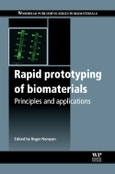Rapid Prototyping of Biomaterials: Principles and Applications provides a comprehensive review of established and emerging rapid prototyping technologies (such as bioprinting) for medical applications. Rapid prototyping, also known as layer manufacturing, additive manufacturing, solid freeform fabrication, or 3D printing, can be used to create complex structures and devices for medical applications from solid, powder, or liquid precursors.
Following a useful introduction, which provides an overview of the field, the book explores rapid prototyping of nanoscale biomaterials, biosensors, artificial organs, and prosthetic limbs. Further chapters consider the use of rapid prototyping technologies for the processing of viable cells, scaffolds, and tissues.
With its distinguished editor and international team of renowned contributors, Rapid Prototyping of Biomaterials is a useful technical resource for scientists and researchers in the biomaterials and tissue regeneration industry, as well as in academia.
- Comprehensive review of established and emerging rapid prototyping technologies (such as bioprinting) for medical applications
- Chapters explore rapid prototyping of nanoscale biomaterials, biosensors, artificial organs, and prosthetic limbs
- Examines the use of rapid prototyping technologies for the processing of viable cells, scaffolds, and tissues
Please Note: This is an On Demand product, delivery may take up to 11 working days after payment has been received.
Table of Contents
- Contributor contact details
- Woodhead Publishing Series in Biomaterials
- Introduction
- Chapter 1: Introduction to rapid prototyping of biomaterials
- Abstract:
- 1.1 Introduction
- 1.2 Definition of rapid prototyping (RP) systems
- 1.3 Basic process
- 1.4 Conventional RP systems and classification
- 1.5 RP of biomaterials
- 1.6 Conclusion and future trends
- 1.7 Sources of further information and advice
- Chapter 2: Freeform fabrication of nanobiomaterials using 3D printing
- Abstract:
- 2.1 Introduction
- 2.2 Laser-based solid freeform fabrication (SFF) techniques
- 2.3 Droplet-based SFF techniques
- 2.4 Nozzle-based SFF techniques
- 2.5 Extrusion freeforming of biomaterials scaffold
- 2.6 Dry powder printing
- 2.7 Conclusion
- Chapter 3: Rapid prototyping techniques for the fabrication of biosensors
- Abstract:
- 3.1 Introduction
- 3.2 Rapid prototyping (RP) of microfluidic systems
- 3.3 Functionalization
- 3.4 Biomaterials compatibility
- 3.5 Conclusion and future trends
- 3.6 Sources of further information and advice
- Chapter 4: Rapid prototyping technologies for tissue regeneration
- Abstract:
- 4.1 Introduction
- 4.2 Rapid prototyping (RP) technologies in tissue regeneration
- 4.3 Laser-assisted techniques
- 4.4 Extrusion-based techniques
- 4.5 Inkjet printing (IP)
- 4.6 Conclusion
- Chapter 5: Rapid prototyping of complex tissues with laser assisted bioprinting (LAB)
- Abstract:
- 5.1 Introduction
- 5.2 Rationale for using laser assisted bioprinting (LAB) in tissue engineering
- 5.3 Terms of reference for LAB
- 5.4 LAB parameters for cell printing
- 5.5 High resolution and high throughput needs and limits
- 5.6 Applications of LAB
- 5.7 Conclusion
- 5.8 Acknowledgements
- Chapter 6: Scaffolding hydrogels for rapid prototyping based tissue engineering
- Abstract:
- 6.1 Introduction
- 6.2 Biomaterials in tissue engineering
- 6.3 Review of commonly used hydrogel-forming scaffolding biomaterials
- 6.4 Applications of scaffolding hydrogels
- 6.5 Conclusion
- Chapter 7: Bioprinting for constructing microvascular systems for organs
- Abstract:
- 7.1 Introduction
- 7.2 Biomimetic model for microvasculature printing
- 7.3 The bio-blueprint for microvasculature printing
- 7.4 Microvasculature printing strategies
- 7.5 Microvasculature post-printing stage
- 7.6 Future trends
- 7.7 Acknowledgements
- Chapter 8: Feasibility of 3D scaffolds for organs
- Abstract:
- 8.1 Introduction
- 8.2 Overview of organ fabrication
- 8.3 The right place: physical properties of the scaffold
- 8.4 The right time: temporal expectations on the scaffold
- 8.5 The right biomaterials: scaffold fabrication effects on non-scaffold components
- 8.6 The right characteristics: material types
- 8.7 The right process: biofabrication
- 8.8 Conclusion
- 8.9 Sources of further information and advice
- Chapter 9: 3-D organ printing technologies for tissue engineering applications
- Abstract:
- 9.1 Introduction
- 9.2 Three-dimensional printing methods for organ printing
- 9.3 From medical imaging to organ printing
- 9.4 Applications in tissue engineering and regenerative medicine
- 9.5 Future trends
- 9.6 Conclusion
- Chapter 10: Rapid prototyping technology for bone regeneration
- Abstract:
- 10.1 Introduction
- 10.2 Bone: properties, structure, and modeling
- 10.3 Engineering of bone tissue
- 10.4 Conventional scaffolds for bone regeneration
- 10.5 Cell printing technology for bone regeneration
- 10.6 Future trends
- 10.7 Conclusion
- 10.8 Acknowledgement
- Chapter 11: Additive manufacturing of a prosthetic limb
- Abstract:
- 11.1 Introduction
- 11.2 The aim in designing a prosthetic limb
- 11.3 A biomimetic approach to design
- 11.4 Integrating functionality
- 11.5 A 'greener' approach to design
- 11.6 Tactile dividends of additively manufactured parts
- 11.7 Vast design flexibility
- 11.8 Conclusion
- Index








